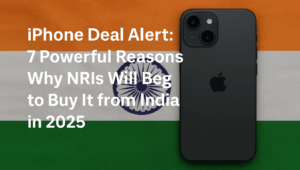iPhone Deal Alert: 7 Powerful Reasons Why NRIs Will Beg You to Buy It from India in 2025
Recent tariff changes in the US under President Donald Trump could make iPhones significantly more expensive, especially for American buyers. With a 54% tariff on Chinese imports and additional charges on products from India (26%) and Vietnam (46%), Apple is facing rising production costs. Analysts predict that US iPhone prices could go up by as much as 43%, with high-end models like the iPhone 16 Pro Max possibly becoming $700 more expensive.
As Apple shifts more production to India, the country could offer a more affordable alternative for sourcing iPhones. This change is prompting many NRIs in the US to consider buying iPhones from India, where local manufacturing may help keep prices lower. As a result, friends and family in India might soon see more requests to bring iPhones during visits. While Apple hasn’t officially raised prices yet, experts warn that increases are likely. For now, NRIs may want to act quickly before the price gap grows wider.

iPhone Deal Alert: 7 Powerful Reasons Why NRIs Will Beg You to Buy It from India in 2025
Recent shifts in U.S. trade policies under former President Donald Trump could soon make iPhones significantly more expensive for American consumers—and unexpectedly, India might emerge as a cost-effective alternative for such purchases. With new tariffs (taxes on imported goods) targeting countries like China and India, Apple devices, including iPhones, could see steep price hikes in the U.S. This has led to speculation that many Non-Resident Indians (NRIs) living in America may turn to friends or family in India to buy iPhones at lower prices.
Why Apple Is Under Pressure
The U.S. recently introduced a 54% tariff on imports from China, directly impacting Apple, which heavily relies on Chinese manufacturing for its products. While the company has begun diversifying its production base to countries like Vietnam and India, these regions are now also subject to new tariffs—46% for Vietnam and 26% for India.
Industry experts suggest that these tariffs could force Apple to raise U.S. prices by 30–40% to offset the added costs. This increase would affect not only iPhones but also other popular devices like iPads and MacBooks. If these projections prove accurate, the latest iPhone models could become hundreds of dollars more expensive, making them less accessible to the average American consumer.
India’s Growing Role in Apple’s Strategy
India is quickly becoming a key manufacturing hub for Apple, thanks to the company’s increasing investments in local production facilities. This shift, combined with India’s relatively lower tariffs compared to China and Vietnam, positions the country as a source of more affordable iPhones. For instance, an iPhone produced in India and sold locally could cost significantly less than the same model sold in the U.S. after the tariff-driven price hike.
This growing price gap may prompt NRIs in the U.S. to seek alternatives. Many could ask relatives or friends visiting from India to bring them iPhones, avoiding the steep prices back home. Analysts estimate that if Apple raises U.S. prices by the expected 43%, buying an iPhone from India could save hundreds of dollars—even after factoring in travel or shipping costs.
What This Means for Consumers
Specific models, like the upcoming iPhone 16 Pro Max, could see price surges of up to $700 in the U.S., according to projections. Even older models, such as the iPhone 11, might not escape these increases. While Apple hasn’t officially confirmed any price changes yet, these forecasts come from analysis by firms like Rosenblatt Securities, which reviewed the impact of Trump’s proposed tariffs on global imports.
For now, these predictions remain speculative. However, the potential for sharp price hikes has already sparked conversations among consumers. NRIs, in particular, are likely to follow the situation closely, weighing the advantages of buying devices through Indian contacts versus paying inflated U.S. retail prices.
Looking Ahead
Apple’s expansion in India not only helps the company navigate geopolitical trade tensions but also supports India’s broader push to strengthen domestic manufacturing. This strategic move could benefit consumers worldwide in the long run by diversifying supply chains and helping stabilize prices. For now, though, the immediate effect of the U.S. tariffs may create a unique situation where buying an iPhone in India becomes a smarter financial choice for those with ties across borders.
If these tariff-driven price hikes take effect, travelers from India to the U.S. might find themselves receiving more iPhone requests than usual. While this kind of cross-border buying isn’t new—it has happened before due to currency fluctuations or pricing differences—the scale of potential savings this time could make the trend even more widespread.
In summary, while Apple’s official pricing strategy remains uncertain, the combination of U.S. tariffs and India’s expanding manufacturing base could reshape how consumers access Apple products. For anyone with connections to India, staying informed on these developments could lead to substantial savings—or at the very least, a suitcase packed with iPhones on your next international trip.
You must be logged in to post a comment.